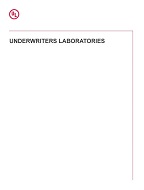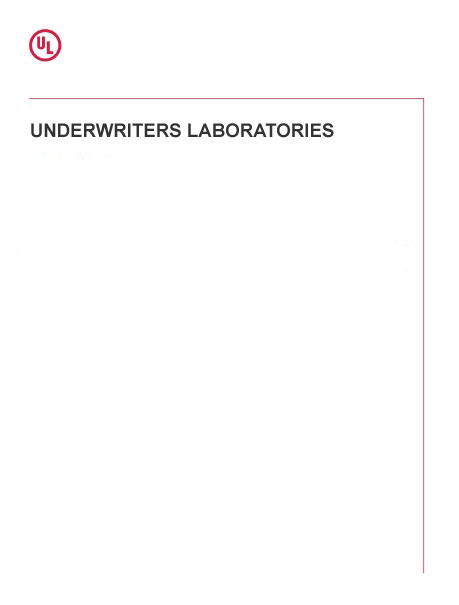
UL 60079-0
Click here to purchase
Explosive atmospheres – Part 0: Equipment – General requirements
UL 60079-0
1 Scope
This part of IEC 60079 specifies the general requirements for construction, testing and marking of electrical equipment and Ex Components intended for use in explosive atmospheres.
1DV.1 Modification of Clause 1, first paragraph to replace with the following:
1DV.1.1 This standard specifies the general requirements for construction, testing and marking of electrical equipment and Ex Components intended for use in explosive atmospheres. Explosive atmospheres are identified by the National Electrical Code, NFPA70 as hazardous (classified) locations and include the following specified locations:
- Class I, Zone 0
- Class I, Zone 1
- Class I, Zone 2
- Zone 20
- Zone 21
- Zone 22
See 6.1 for the relationship of the Equipment Protection Level (EPL) to the zone area classification. The standard atmospheric conditions (relating to the explosion characteristics of the atmosphere) under which it may be assumed that electrical equipment can be operated are:
- temperature -20 °C to +60 °C
- pressure 80 kPa (0,8 bar) to 110 kPa (1,1 bar); and
- air with normal oxygen content, typically 21 % v/v.
This standard and other standards supplementing this standard specify additional test requirements for equipment operating outside the standard temperature range, but further additional consideration and additional testing may be required for equipment operating outside the standard atmospheric pressure range and standard oxygen content, particularly with respect to types of protection that depend on quenching of a flame such as `flameproof enclosure “d” – ( IEC 60079-1) or limitation of energy, `intrinsic safety “i” – ( IEC 60079-11).
1DV.2 Modification of Clause 1, third paragraph as follows:1DV.2.1 Delete “(IEC 60079-1)” and “(IEC 60079-11)”
NOTE 1 Although the standard atmospheric conditions above give a temperature range for the atmosphere of -20 °C to +60 °C, the normal ambient temperature range for the equipment is -20 °C to +40 °C, unless otherwise specified and marked. See 5.1.1. It is considered that -20°C to +40°C is appropriate for most equipment and that to manufacture all equipment to be suitable for a standard atmosphere upper ambient temperature of +60°C would place unnecessary design constraints.
NOTE 2 Requirements given in this standard result from an ignition hazard assessment made on electrical equipment. The ignition sources taken into account are those found associated with this type of equipment, such as hot surfaces, mechanically generated sparks, mechanical impacts resulting in thermite reactions, electrical arcing and static electric discharge in normal industrial environments.
NOTE 3 It is acknowledged that, with developments in technology, it may be possible to achieve the objectives of the IEC 60079 series of standards in respect of explosion prevention by methods that are not yet fully defined. Where a manufacturer wishes to take advantage of such developments, this International Standard, as well as other standards in the IEC 60079 series, may be applied in part. It is intended that the manufacturer prepare documentation that clearly defines how the IEC 60079 series of standards has been applied, together with a full explanation of the additional techniques employed. The designation “Ex s” has been reserved to indicate special protection. A standard for special protection “s”, IEC 60079-33, is in preparation.
1DV.3 Modification of Clause 1 to delete NOTE 3.1DV.3.1 This NOTE does not apply.
NOTE 4 Where an explosive gas atmosphere and a combustible dust atmosphere are, or may be, present at the same time, the simultaneous presence of both should be considered and may require additional protective measures.This standard does not specify requirements for safety, other than those directly related to the explosion risk. Ignition sources like adiabatic compression, shock waves, exothermic chemical reaction, self ignition of dust, naked flames and hot gases/liquids, are not addressed by this standard.
NOTE 5 Such equipment should be subjected to a hazard analysis that identifies and lists all of the potential sources of ignition by the electrical equipment and the measures to be applied to prevent them becoming effective.This standard is supplemented or modified by the following standards concerning specific types of protection:- IEC 60079-1: Gas – Flameproof enclosures “d”;- IEC 60079-2: Gas – Pressurized enclosures “p”;- IEC 60079-5: Gas – Powder filling “q”;- IEC 60079-6: Gas – Oil immersion “o”;- IEC 60079-7: Gas – Increased safety “e”;- IEC 60079-11: Gas – Intrinsic safety “i”;- IEC 60079-15: Gas – Type of protection “n”;- IEC 60079-18: Gas and dust – Encapsulation “m”;- IEC 60079-31: Dust – Protection by enclosure “t”- IEC 61241-4: Dust – Pressurization “pD”;1DV.4 Modification of Clause 1, sixth paragraph to replace with the following:- ISA 60079-2: Gas – Pressurized enclosures “p”;- ISA 60079-31: Dust – Protection by enclosure “t”;- ISA 61241-4: Dust – Pressurization “pD”;- UL 60079-1: Gas – Flameproof enclosures “d”;- UL 60079-5: Gas – Powder filling “q”;- UL 60079-6: Gas – Oil immersion “o”;- UL 60079-7: Gas – Increased safety “e”;- UL 60079-11: Gas – Intrinsic safety “i”;- UL 60079-15: Gas – Type of protection “n”;- UL 60079-18: Gas and dust – Encapsulation “m”;NOTE 6 Additional information on types of protection for non-electrical equipment can be found in ISO/IEC 80079-36 (to be published).This standard is supplemented or modified by the following equipment standards: IEC 60079-13: Explosive atmospheres – Part 13: Equipment protection by pressurized room “p” IEC 60079-25: Explosive atmospheres – Part 25: Intrinsically safe electrical systems IEC 60079-26: Explosive atmospheres – Part 26: Equipment with equipment protection level (EPL) Ga IEC 60079-28: Explosive atmospheres – Part 28: Protection of equipment and transmission systems using optical radiation IEC 62013-1: Caplights for use in mines susceptible to firedamp – Part 1: General requirements – Construction and testing in relation to the risk of explosion IEC 60079-30-1: Explosive atmospheres – Part 30-1: Electrical resistance trace heating – General and testing requirements.
1DV.5 Modification of Clause 1, sixth paragraph to replace with the following which deletes IEC 60079-13, IEC 62013-1, IEC 60079-30-1 and adds ANSI/IEEE 514 and NOTE 7:
1DV.5.1 This standard is supplemented or modified by the following equipment standards: ISA 60079-25 (12.02.05): Explosive atmospheres – Part 25: Intrinsically safe electrical systems IEC 60079-26 (12.00.03): Explosive atmospheres – Part 26: Equipment with equipment protection level (EPL) Ga IEC 60079-28 (12.21.02): Explosive atmospheres – Part 28: Protection of equipment and transmission systems using optical radiation ANSI/IEEE 515: Standard for Testing, Design, Installation, and Maintenance of Electrical Heat Tracing for Industrial Applications.
NOTE 7 Components such as power connections, splices, end terminations, as well as cable entries, fittings, and seals, are to be evaluated according to the type of protection employed.This standard with the additional standards mentioned above, are not applicable to the construction of electromedical apparatus, shot-firing exploders, test devices for exploders, and shot-firing circuits.1DV.6 Addition of 1DV.6.11DV.6.1 Where references are made to other IEC 60079 standards, the referenced requirements found in these standards shall apply as modified by any applicable U.S. National Differences.
Product Details
- Edition:
- 6
- Published:
- 07/26/2013
- Number of Pages:
- 170

